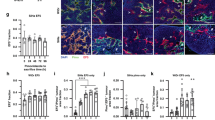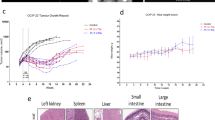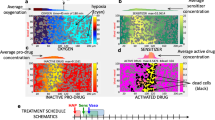Abstract
We have investigated the effects of localised tumour hyperthermia (LTH; 43.5 degrees C x 30 min) on the acute toxicity and pharmacokinetics of the hypoxic cell sensitizer pimonidazole (Ro 03-8799) in mice. There were three treatment groups: unrestrained controls, sham-treated and LTH treated mice. LTH had minimal effects on the acute toxicity (LD50/7d) of pimonidazole with no significant difference between the three treatment groups. Pharmacokinetic studies were carried out at the maximum tolerated dose (MTD; approximately 60% LD50) of 437 micrograms g-1 i.v. in plasma, brain and tumour. Sham tumour treatment consistently increased plasma drug concentrations compared to unrestrained controls but had minimal effects on the elimination t1/2. The AUC0-infinitive was increased by 35% and the plasma clearance decreased by 26%. By contrast, LTH had minimal effects on these parameters compared to sham treatment. Brain pimonidazole concentrations were increased in restrained mice (sham and LTH treatments) compared to unrestrained controls, but average brain/plasma ratios were similar in all three groups at between 400 and 500%. Sham tumour treatment markedly reduced peak tumour pimonidazole concentrations compared to unrestrained controls giving a 29% lower AUC0-180min. Average tumour/plasma ratios were reduced from 236 to 129%. The most important finding was that LTH further reduced pimonidazole tumour concentrations, giving a 31% lower AUC0-180 min compared to sham treated tumours. Tumour/plasma ratios for pimonidazole were reduced by 41%. Plasma exposure to the pimonidazole N-oxide metabolite, Ro 31-0313, was unaltered by LTH. The markedly reduced drug concentrations in heated tumours may be a result of hyperthermia-stimulated bioreductive drug activation.
This is a preview of subscription content, access via your institution
Access options
Subscribe to this journal
Receive 24 print issues and online access
$259.00 per year
only $10.79 per issue
Buy this article
- Purchase on Springer Link
- Instant access to full article PDF
Prices may be subject to local taxes which are calculated during checkout
Similar content being viewed by others
Author information
Authors and Affiliations
Rights and permissions
About this article
Cite this article
Walton, M., Bleehen, N. & Workman, P. Effects of localised tumour hyperthermia on pimonidazole (Ro 03-8799) pharmacokinetics in mice. Br J Cancer 59, 667–673 (1989). https://doi.org/10.1038/bjc.1989.138
Issue Date:
DOI: https://doi.org/10.1038/bjc.1989.138
This article is cited by
-
Transiently hypoxic tumour cell turnover and radiation sensitivity in human tumour xenografts
British Journal of Cancer (2022)
-
Local hypoxia is produced at sites of intratumour injection
British Journal of Cancer (2002)



